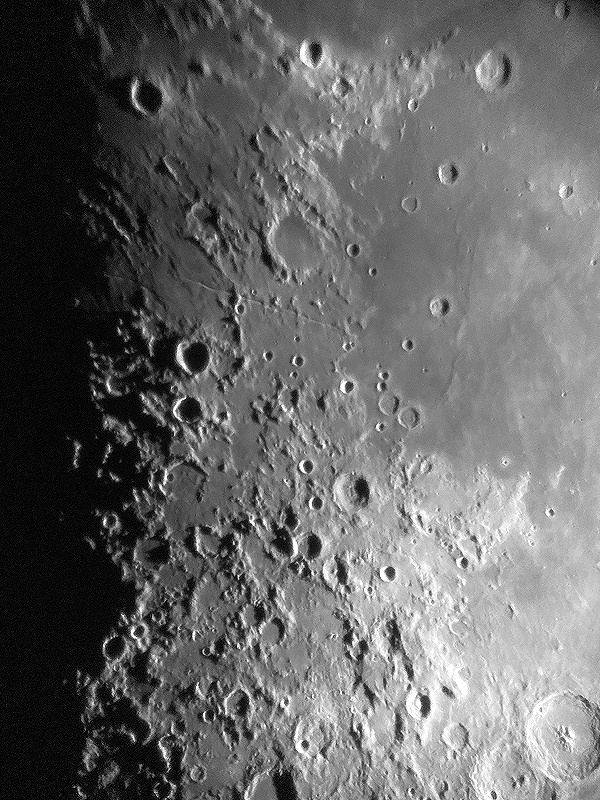iPhone Moon, Jupiter, Saturn, and Mars
Posted: 24 September 2020
Sunday, 20 September 2020, dawned with a unforecasted overcast sky. The clouds continued on Monday, 21 September, and the sky was still hazy from the California wildfires smoke. That morning we had the large mesquite tree near the observatory trimmed to remove low hanging dead branches.

Cloudy skies continued until Wednesday, 23 September. The haziness from the California wildfires smoke decreased.
|
Open: Wednesday, 23 September 2020, 1806 MST Temperature: 84°F |
Session: 1520 Conditions: Clear |
Equipment:
12" f/8 LX600 w/StarLock
2" 24mm UWA eyepiece
2" 30mm eyepiece
2" 5.5mm 100° eyepiece
2" 14mm 100° eyepiece
2" 9mm 100° eyepiece
Camera:
iPhone 11 Pro Max
1816 MST: LX600 ON, StarLock OFF, High Precision OFF.
Viewed the First Quarter Moon, 102X
1821 MST: sunset.
Next, I tested the iOS app ScopeBoss with iOS 14. It worked fine to control the LX600 telescope using the Meade Stella Wi-Fi Adapter.
Viewed Jupiter and 3 moons, 102X. Seeing was pretty good this night.
Viewed the Moon, 81X.
1832 MST: I then relaxed on the observatory patio bench to wait for the sky to get darker.
1900 MST: back inside the observatory.
Mounted the iPhone on the 2" 30mm eyepiece using the Levenhuk Smartphone Adapter. Took this image of the Moon, afocal 81X, using the iOS app NightCap Camera (ISO 32, 1/610sec, 1X lens).

I did some lunar observing, 443X. Nice sights.
Mounted the iPhone on the 2" 5.5mm eyepiece using the Levenhuk adapter. Took this afocal 443X photos along the lunar terminator using NightCap Camera (ISO 100, 1/60sec and 1/120sec, 1X lens).





Removed the iPhone and viewed Jupiter and 4 moons, 443X. Mounted the iPhone again and took this afocal 443X image of Jupiter using NightCap Camera (ISO 100, 1/25sec, 1X lens).

iPhone afocal 443X image of Saturn with NightCap Camera (ISO 500, 1/60sec, 1X lens).

1945 MST: viewed Saturn, 433X. The view was way better than the image.
I then relaxed on the bench. It was nice to be under the stars even with the bright moonlit sky from the First Quarter Moon. The Milky Way was faintly visible overhead. M31 (Andromeda Galaxy) was faintly visible. While I was relaxing outside my Made-in-Canada SkyShed POD observatory I was listening to music by the Canadian Brass.
2019 MST: bright Mars was rising over the hill to the east.
2103-2111 MST: took a short break.
Viewed Mars, 174X. This was my first telescopic view of Mars as it approaches opposition (in October). Mars was too low for good viewing but at times there were some details visible: South Polar Ice Cap, clouds in the north, and some dark surface areas.
2120 MST: back to the bench for awhile to let Mars rise higher. I did some sky observing using the Vortex 12x50 binoculars: Jupiter and 2 moons, Saturn and its Ring, the disk of Mars, M31 (Andromeda Galaxy) and its satellite galaxies M32 and M110, the Double Cluster (open star clusters), M33 (Triangulum Galaxy), M45 (the Pleiades), and the First Quarter Moon.
2200 MST: back inside the observatory.
Viewed the planets Neptune and Uranus, 174X and 443X.
2210 MST: viewed Mars, 443X. Too bright! Added one of the 2" Zhumell Variable Polarizing Filters (VPF) to reduce the planet's brightness.
Mounted the iPhone on the 5.5mm eyepiece. Took this afocal 443X + VPF1 image of Mars using NightCap Camera (ISO 32, 1/60sec, 1X lens).

Seeing was not very good now. Switched to 271X and viewed Mars with the filter. The view was slightly better at the lower magnification. Then viewed Mars, 102X.
2254 MST: LX600 OFF.
|
Close: Wednesday, 23 September 2020, 2306 MST Temperature: 74°F |
Session Length: 5h 00m Conditions: Clear |
Comments are welcome using Email. Twitter users can use the button below to tweet this report to their followers. Thanks.
Cassiopeia Observatory Home Page
Copyright ©2020 Michael L. Weasner / mweasner@me.com
URL = http://www.weasner.com/co/Reports/2020/09/24/index.html
